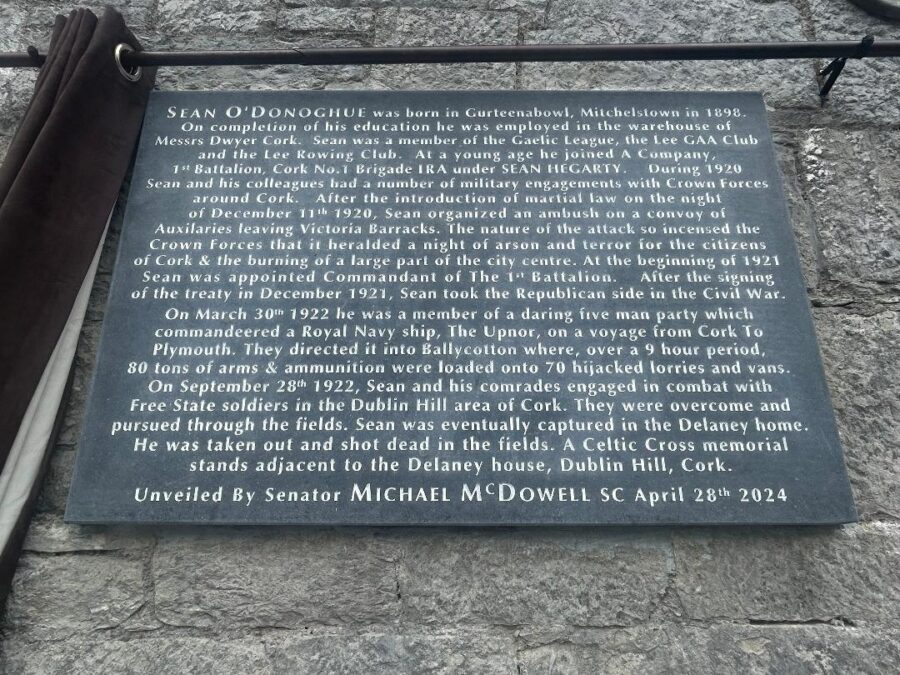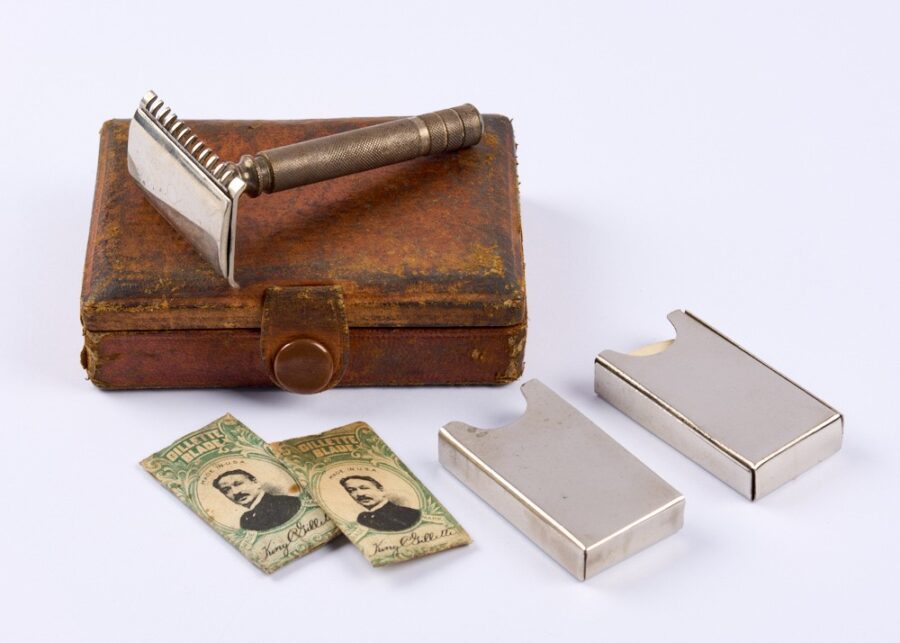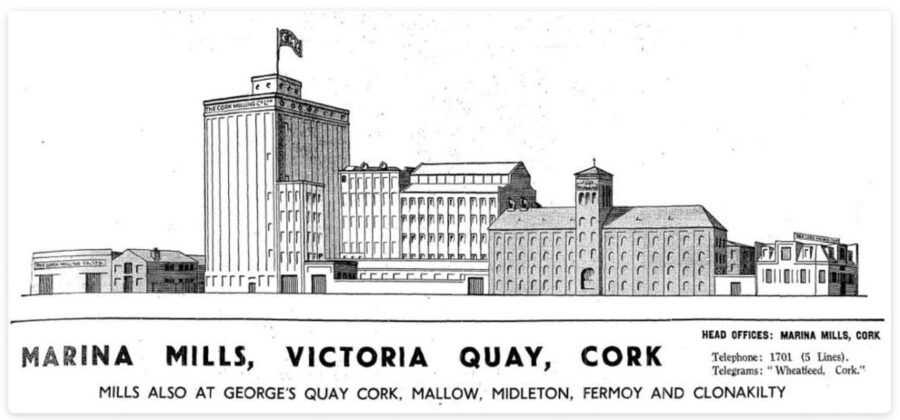
Kieran’s Our City, Our Town Article,
Cork Independent, 9 May 2024
Ballygiblin Memorial to Seán O’Donoghue
A new memorial has been unveiled in Ballygiblin, Mitchelstown to the memory of Seán O’Donoghue (1898-1922), Commandant of the Cork No.1 Brigade, 1st Battalion who was deeply involved in the Irish War of Independence in Cork City.
The associated memorial booklet is now on sale in book shops in Mitchelstown. The text compiled by the memorial committee outlines that baptised as John, Seán was born in Gurteenabowl, Mitchelstown in 1898. He was the 5th child born to his parents William & Nano (nee O’Mahony) O’Donoghue.
On completion of his education, he was employed in the warehouse of Messrs Dwyer, Cork and he lived with his aunt in Roches Buildings. Seán was a member of the Gaelic League, the Lee GAA Club and the Lee Rowing Club. At an early age he joined A Company, 1st Battalion, Cork No 1 Brigade, becoming Quartermaster of the company. He was subsequently promoted to Quartermaster of the Cork Brigade. At the beginning of 1921, he was appointed Commandant of the 1st Battalion.
A loyal and courageous officer, Seán was involved in several engagements with the Black and Tans in Cork and at the signing of the Treaty, he took the Republican side in the Civil War.
On the afternoon of Saturday, 11 December, the day after Martial Law had been declared, in the south of Ireland, Sean O’Donoghue received word that a party of Auxillaries travelling in two lorries would depart Victoria Barracks that night at 8pm. The report also mentioned the possibility that Captain Campbell Kelly, a British Army intelligence officer based at Victoria Barracks who was known to torture IRA prisoners, would be travelling with them.
The IRA considered Captain Kelly a major threat and were anxious to eliminate him. Armed with this information, O’Donoghue decided to act. Though time was short he managed to muster the following Volunteers: Michael Baylor, Seán Healy, Michael Kenny, Augustine O’Leary and James O’Mahony. He also sent word to Anne Barry to have the grenades ready. As darkness fell, she took them from her home and hid them in the front garden of a house owned by the Lennox family at Mount View on the Ballyhooly Road.
Under the cover of darkness, the men took up their positions behind the wall between Balmoral Terrace and the houses at the corner of Dillon’s Cross. Michael Kenny took up position at Harrington Square, on the opposite side of the road to the ambush party and within braking distance of the ambush position.
Michael Kenny wore a mackintosh overcoat, scarf and cap to give the impression that he was an off-duty British soldier. His task was to act as a lookout and to slow down the lorries as they approached the ambush position. At approximately 8pm, the two lorries, each containing 13 Auxillaries, left the barracks and drove towards Dillon’s Cross. As the leading lorry approached Harrington Square, Michael Kenny stepped out to the edge of the footpath, put up his hand and signalled the driver to stop. As he slowed down, the second lorry passed, Kenny gave the signal to the men behind the wall. He then made his escape to the IRA hideout in Rathcooney.
At the signal the ambush stood up and hurled bombs at their target. As the bombs exploded, they each drew their revolvers and fired at the Auxillaries, before making their escape. Seán O’Donoghue and James O’Mahony made their way to the Delaney farm at Dublin Hill. Seán was carrying the unused bombs and he hid these on the Delaney land. The two men split up and went on the run.
This ambush heralded a night of arson and terror for the citizens of Cork, culminating in the burning of a large part of the city centre.
The turbulence behind the Pro-Treaty and Anti-Treaty sides took a darker turn when across February, March and April 1922, the IRA, particularly Anti-Treaty elements, began to seize sizable amounts of weapons from evacuating British forces. The steamship Upnor was a small British Army stores carrier of about 500 tonnes deadweight. She was loading at the ordnance stores on Rocky Island with arms and ammunition from the recently disbanded Royal Irish Constabulary for Plymouth when Seán O’Donoghue and his comrades of the 1st Brigade, 1st Southern Division of the IRA got to hear of it.
A well organised and executed operation followed. On 29 March, the Upnor sailed. This was reported by intelligence sources in Cobh and the plan swung into action. The Admiralty tug Warrior, crewed mostly by local men was at the Deepwater Quay in Cobh. Her master was enticed ashore and Captain Jeremiah Collins, a master mariner, IRA officers – Seán O’Donoghue, Dan Donovan, Michael Murphy and Seán O’ Hearty boarded with some volunteers and took the ship to sea some hours after the Upnor.
By means of a ruse, they caused the Upnor to heave to and even though the Upnor‘s master was suspicious, he let them come alongside. Sean O’Donoghue and his contingent boarded and captured the ship and she was brought to Ballycotton at 4am on 30 March. Meanwhile a large number of lorries and cars had been commandeered and brought to Ballycotton. The town had been sealed off and when the Upnor arrived, she was quickly unloaded and her contents dispersed inland.
On 28 September 1922, a party of Irish Free Government’s National Army forces consisting of one officer and ten soldiers had been operating in the Carrignavar, Whitechurch and White’s Cross districts, carrying out searches. At approximately 3.45pm when they reached a point some two miles beyond Dublin Hill, Blackpool, and about a mile from the place where the motors were seized, they were ambushed by Seán O’Donoghue and his comrades, who were in occupation of strong positions and poured a hail of bullets in the direction of the National Army troops, who were forced to halt their cars and alight, proceeding to engage with Seán and company. A brief fight was sufficient to rout them and the soldiers pursued them across country for a considerable distance.
Sadly, Seán O’Donoghue was located, removed from the Delaney family home and killed by the Free State Government troops in a field nearby. His body was brought to Cork by the troops.
A Celtic cross memorial now stands near the Delaney family home at Dublin Hill, Cork. Commadant Seán O’Donoghue’s name is inscribed on this memorial. The new Ballygiblin memorial also recognises Seán’s contribution to the Irish War of Independence and the tragedy of the ensuing Irish Civil War.
Caption:
1252a. New memorial to Seán O’Donoghue, Ballygiblin, Mitchelstown (picture: Kieran McCarthy).


